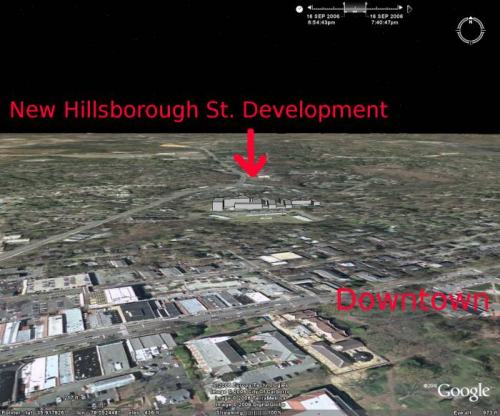I’ve followed the ins-and-outs of Raleigh’s Carlton Place before the Wallace Deck/Lot #5 developments took flight.
64 of the 80 units – ranging in size from 800 to 1200 sq./ft. – are priced so those making %60 of Wake County’s median income can afford one.
Market rates aren’t too shabby either (market/affordable): 1 BR/1 BA $700/$550 or less, 1 BR/1 BA (with Den) $750/$570, 2 BR/2 BA $875/$600, 3 BR/2 BA $1,100/$670.

Located at the intersection of E. Davie Street and S. Bloodworth Street, less than two blocks from Moore Square, City Market, and the Exploris and Moore Square Museums Magnet middle schools. Its central location provides residents with easy access to all of downtown’s employment, shopping, professional services, public transit, and cultural and recreational opportunities.
Amenities found at Carlton Place include on-site management and maintenance; a variety of one-, two- and three-bedroom floor plans ranging from about 800 to 1200 square feet; a fitness room, business center and laundry room; walk-in closets; washer and dryer hook-ups; cable television and Internet connections; a picnic area and tot lot; and private, off-street parking.
In addition to the on-site amenities, the project was built to include green design elements that help make it an environmentally friendly and cost-effective place to live. Among the green features of the project are: Energy Star appliances; high efficiency heat pumps; low-VOC carpet and paint; carpet padding made from recycled materials; pervious concrete; and native, drought-resistant plants for landscaping.
Off street parking? Are they nuts?
By contrast, the Lot 5 development offers compact affordable units: “21 one-bedroom units be provided in the project, with a square footage averaging 643 square feet.” Qualification starts at %80 of the regional salary (little less than $50K), with the purchase price set accordingly (to what someone earning $50K/year could “afford”). Condo fees capped at %1.5 of that sales price of the affordable units plus utilities.
Of course, folks will “own” their apartment on Lot #5 while those at Carlton Place will only rent. Chapel Hill’s condo owners, then, will experience a modest growth in equity and see a return on their investment (minus the %1.5 yearly fees) while those in Raleigh don’t.
Ownership is supposed to also reduce unit churn – a favored attribute over apartments – an attribute that appears to be unique to Lot #5 as our local affordable housing advocate Robert Dowling noted when commenting on “Mr. Meadowmont” Roger Perry’s new East 54 (University Inn) project:
Meadowmont developer Roger Perry is planning a major project that challenges the town’s inclusionary affordable housing model.
In exchange for the town’s approving high density — half a million square feet on 11 acres — Perry is offering to double the town’s requirement: 30 percent affordable housing, or 60 out of 200 condos.
Robert Dowling, executive director of the nonprofit Orange Community Housing and Land Trust, praised the idea. But he urged the Town Council to reject it. Dowling said the flood of condos would be harder to manage because condos are smaller starter homes that few people would live in for very long.
Lower-cost condos criticized The News & Observer February 17, 2007
Perry’s East 54 units “one- and two-bedroom units would range in size from 700 to 1,000 square feet and would be priced somewhere in the low $100,000s”.
Bigger, cheaper but will churn faster than those condos on Lot #5? Doesn’t compute.
Back to Raleigh, the taxpayers’ outlay was at least 5-fold less than our taxpayers, $1.5M to our $7.5M.
A $1.5 million loan from the city and county helped the non-profit housing company, DHIC, develop a $10 million project. Apartments are available to families earning 60 percent of the median income. In Raleigh, that’s $43,000 for a family of four.
Larger, cheaper units with on-site parking, no condo fees, many amenities without creating a slew of publicly financed million dollar condos? That computes.
What about that housing cost disparity?
“It’s so important for downtown to give opportunities for multiple classes to help build a life in downtown,†said Kris Larson, deputy director of the Downtown Raleigh Alliance.
It allows people who work in the service industry downtown to live downtown.
“If only people who can live here have to buy a $350,000 condo, what kind of community is that, it’s not very diverse or vibrant,†said Natalie Connell, of DHIC.
Vibrancy. That also computes.
What kind of mix of residents will live in our publicly underwritten Lot #5? Well-to-do students, young professionals, retirees that can drop between $300,000 and $1 million plus on housing?
Raleigh designed in diversity and environmental sanity from the start with their Carlton Place project, as the ‘blog Raleighing reports (Carlton Place Opens With Fanfare):
Eight of the units are set aside for, and affordable to, persons with disabilities. Additionally, 4 units are fully accessible to people with mobility impairments, including curbless showers. One resident benefiting from this is Raleigh native and reigning Ms. Wheelchair North Carolina, Ms. Kelly Woodall.
Carlton Place also received a grant from the Home Depot Foundation to incorporate “Green†elements in the design of the development. Carlton Place features Energy Star appliances, low VOC paint and carpet, pervious concrete, low flow plumbing, and solar reflective roof membranes.
According to Gregg Warren, Executive Director of DHIC, the first residents are employees of The City of Raleigh, Wake County Public Schools, Blue Cross Blue Shield, Capital Area Transit, retail businesses, state government, and Wake Med. Many are now able to walk to work. DHIC is also the developer of Murphy School Apartments and the Prairie Building in downtown Raleigh.
End of the day? If increasing Downtown’s population, diversity and vibrancy in a sustainable, environmentally sound fashion is your goal, Raleigh’s Carlton Place suggests some solutions.





















